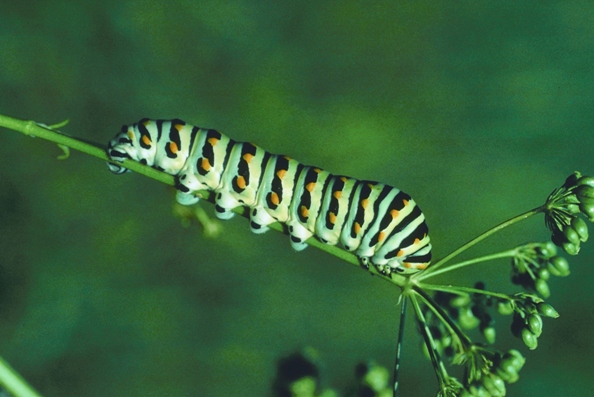
There are a number of caterpillar pests that feed on vegetable and garden plants. One approach to dealing with young caterpillar pests is to apply sprays of products that contain the active ingredient, Bacillus thuringiensis spp. kurstaki (Btk), which is commercially available under various trade names including Dipel and Thuricide. Btk is a soil-borne bacterium that is widely used to control populations of many caterpillar pests that feed on plants such as bagworm, webworms, tobacco budworm, imported cabbageworm, cabbage looper, diamondback moth, and tomato hornworm.
However, Btk is not effective against caterpillars that feed in twigs or wood (wood-boring caterpillars); nor is it effective against the corn earworm. Btk is a stomach poison and needs to be ingested in order to be active. This means that thorough coverage of all plant parts is essential so that the target caterpillar pest will encounter and consume the bacteria. Once the bacteria are consumed, it produces an endotoxin crystal that attacks the mid-gut membrane and creates pores, causing leakage and swelling. The swelling continues until cells burst, which allows the gut contents to leak into the insect’s blood (hemolymph), disrupting the blood pH and resulting in paralysis. As such, caterpillars stop feeding within 48 hours and die after 2 to 3 days.
Only caterpillars are susceptible to Btk because they have alkaline gut pH that is greater than 7. It is important to understand the following characteristics of Btk products in order to maximize their effectiveness in controlling populations of caterpillar pests on ornamental plants and vegetables.
Selectivity
In contrast to conventional insecticides such as acephate (Orthene), carbaryl (Sevin), and pyrethroid insecticides (e.g., bifenthrin, cyfluthrin, esfenvalerate, lambda-cyhalothrin, and gamma-cyhalothrin), Btk products don’t have a broad-spectrum of activity. They only kill caterpillars. As such, they generally have minimal direct impact on non-target organisms or natural enemies (e.g., parasitoids and predators), which results in fewer problems associated with increased insect or mite pest populations due to secondary pest outbreak or target pest resurgence when broad-spectrum insecticides/miticides are applied. Btk products have no activity on piercing-sucking insects and mites such as aphids, whiteflies, and spider mites. An alternative pesticide (insecticide or miticide) must be used if piercing-sucking insect or mite pests are causing problems.
Timing of Application
Products containing Btk as the active ingredient must be applied when caterpillars are young because of their small size; the caterpillars don’t have to consume as much plant material before the bacteria is effective. They will also be killed before they cause severe plant damage. If Btk is applied too late, caterpillars have to consume much more plant material in order for the active ingredient to be effective. This may result in plant damage since it takes longer to kill the caterpillars. In addition, the caterpillar may switch from the growing phase to the reproductive phase before actually consuming enough of the bacteria. As such, less material will be consumed and there is a higher probability of adult survival, which means a new generation of caterpillars will be produced.
Residual Activity
Btk products don’t last long in the environment as they are subject to sunlight (ultra-violet light) degradation and removal during rainfall. As such, repeat applications are typically required.
Speed of Activity
Btk products are slower-acting than most conventional insecticides and so they must be applied before caterpillar pest populations reach damaging levels.
Safety
The mode of action of Btk is specific for caterpillars. There are no direct and indirect effects on humans or mammals.
Storage Life
Products with Btk as the active ingredient must be stored at temperatures between 50ºF and 60ºF to prolong their shelf life. Avoid exposing products to extremes in cold (<40ºF) or warm (>80ºF) temperatures, which may cause fragmentation of the bacteria.
Water Quality
Alkaline water (pH >7) may reduce the effectiveness of the toxin, so the spray solution must be adjusted to a pH of 6.0 to 6.5.
Products containing Btk may be useful in controlling caterpillar pest populations on ornamental plants (trees and shrubs), herbaceous annuals and perennials, and vegetables and fruits; however, it is important to understand their benefits and limitations so as to use them effectively.
Dr. Raymond A. Cloyd is a Professor and Extension Specialist in Ornamental Entomology/Integrated Pest Management in the Department of Entomology at Kansas State University. He can be contacted at:
Dr. Raymond A. Cloyd
Kansas State University
123 Waters Hall
Manhattan, KS 66506
P – 785.532.4750
Email: rcloyd@ksu.edu
Related Articles & Free Email Newsletter
Neem Oil is an Amazing Product
Understanding Stressed Trees: Insects, Disease & Environment




Comment here